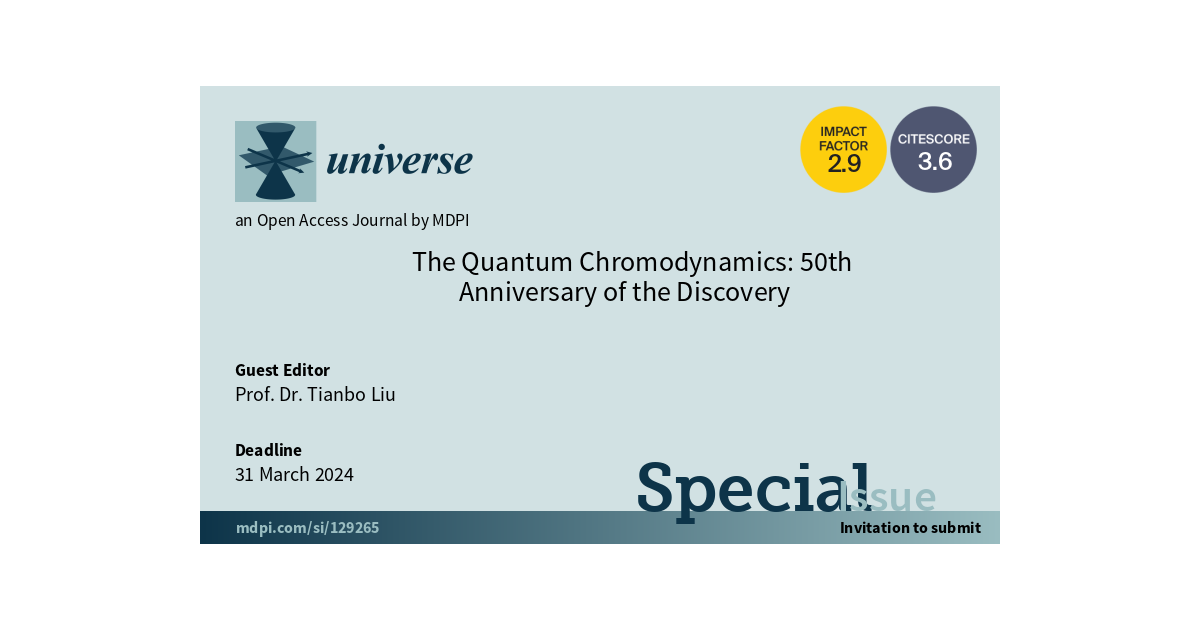The Quantum Chromodynamics: 50th Anniversary of the Discovery
A special issue of Universe (ISSN 2218-1997). This special issue belongs to the section "High Energy Nuclear and Particle Physics".
Deadline for manuscript submissions: closed (31 March 2024) | Viewed by 5756

Special Issue Editor
Special Issue Information
Dear Colleagues,
One of the greatest achievements of physics in the second half of the 20th century is the establishment of the standard model, which describes the strong, electromagnetic and weak interactions among particles in the visible universe. The quantum chromodynamics (QCD) is the underlying theory of strong interactions. It has the properties of asymptotic freedom at short distance and color confinement at long distance. While confinement is crucial for the stability of protons and the living world, it prevents direct observation of quarks and gluons, the fundamental degrees of freedom in QCD, by any modern detectors. Given the nonperturbative nature of QCD at hadronic scales, it remains a challenging issue to directly calculate all properties of hadrons from first principles. Many experimental measurements, such as electron-positron annihilation, electron–nucleon scattering, proton-proton and heavy-ion collisions, have been performed to learn the properties of strong interactions from different aspects. However, our understanding of the strong interaction is still far from a satisfactory level after more than 50 years since the quark model and the pioneer studies of nucleon partonic structures. Therefore, extensive programs are proposed at the future electron-ion collider, including precise measurements of the gluon and sea quark contents of the nucleon, the 3D tomography of nucleon, the partonic structure of nuclei, the parton interaction with the nuclear environment, and the exotic states, to address fundamental issues of the origin of nucleon mass and spin and the emergence of color neutral hadrons from quarks and gluons.
This Special Issue aims at a collection of both overview and original research, covering every aspect of QCD and hadron physics, including hadron spectroscopy, exotic states, nucleon structures, parton distribution and fragmentation functions, jets, heavy quarks, perturbative and nonperturbative methods. Both theoretical and experimental works are welcome. Papers related to current and future experiments are particularly encouraged.
Prof. Dr. Tianbo Liu
Guest Editor
Manuscript Submission Information
Manuscripts should be submitted online at www.mdpi.com by registering and logging in to this website. Once you are registered, click here to go to the submission form. Manuscripts can be submitted until the deadline. All submissions that pass pre-check are peer-reviewed. Accepted papers will be published continuously in the journal (as soon as accepted) and will be listed together on the special issue website. Research articles, review articles as well as short communications are invited. For planned papers, a title and short abstract (about 100 words) can be sent to the Editorial Office for announcement on this website.
Submitted manuscripts should not have been published previously, nor be under consideration for publication elsewhere (except conference proceedings papers). All manuscripts are thoroughly refereed through a single-blind peer-review process. A guide for authors and other relevant information for submission of manuscripts is available on the Instructions for Authors page. Universe is an international peer-reviewed open access monthly journal published by MDPI.
Please visit the Instructions for Authors page before submitting a manuscript. Submitted papers should be well formatted and use good English. Authors may use MDPI's English editing service prior to publication or during author revisions.
Keywords
- parton distribution
- fragmentation function
- nucleon spin
- exotic states
- jets
- electron-ion collider
- QCD factorization
- nonperturbative method





